Food Safety Management and Business Development Plan for Hutong
VerifiedAdded on 2023/06/18
|16
|5295
|383
Report
AI Summary
This report provides a detailed analysis of food safety management and business development strategies for Hutong, a popular restaurant specializing in Northern Chinese cuisine. It covers various aspects of food service, including different food supply chain approaches (long, short, and outsourced), effective procurement and sourcing principles, and key stakeholders in the food supply chain. The report also examines analytical tools like SWOT and PESTLE for effective management strategies, ethical practices, and recommendations for enhancing operational effectiveness. Furthermore, it includes a business development plan with management practices, performance review techniques, implementation plans, and solutions to address shortcomings and challenges for overall growth.
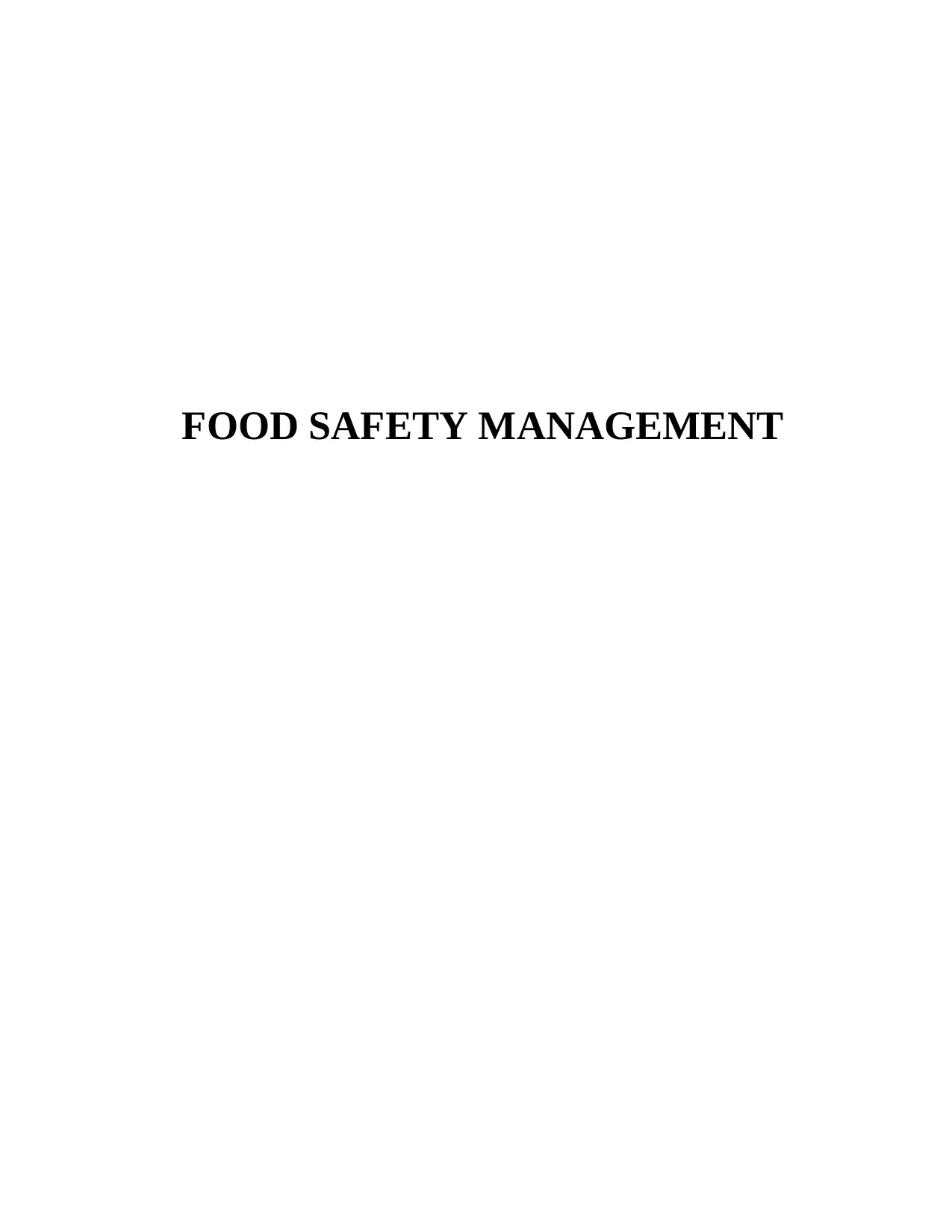
FOOD SAFETY MANAGEMENT
Paraphrase This Document
Need a fresh take? Get an instant paraphrase of this document with our AI Paraphraser
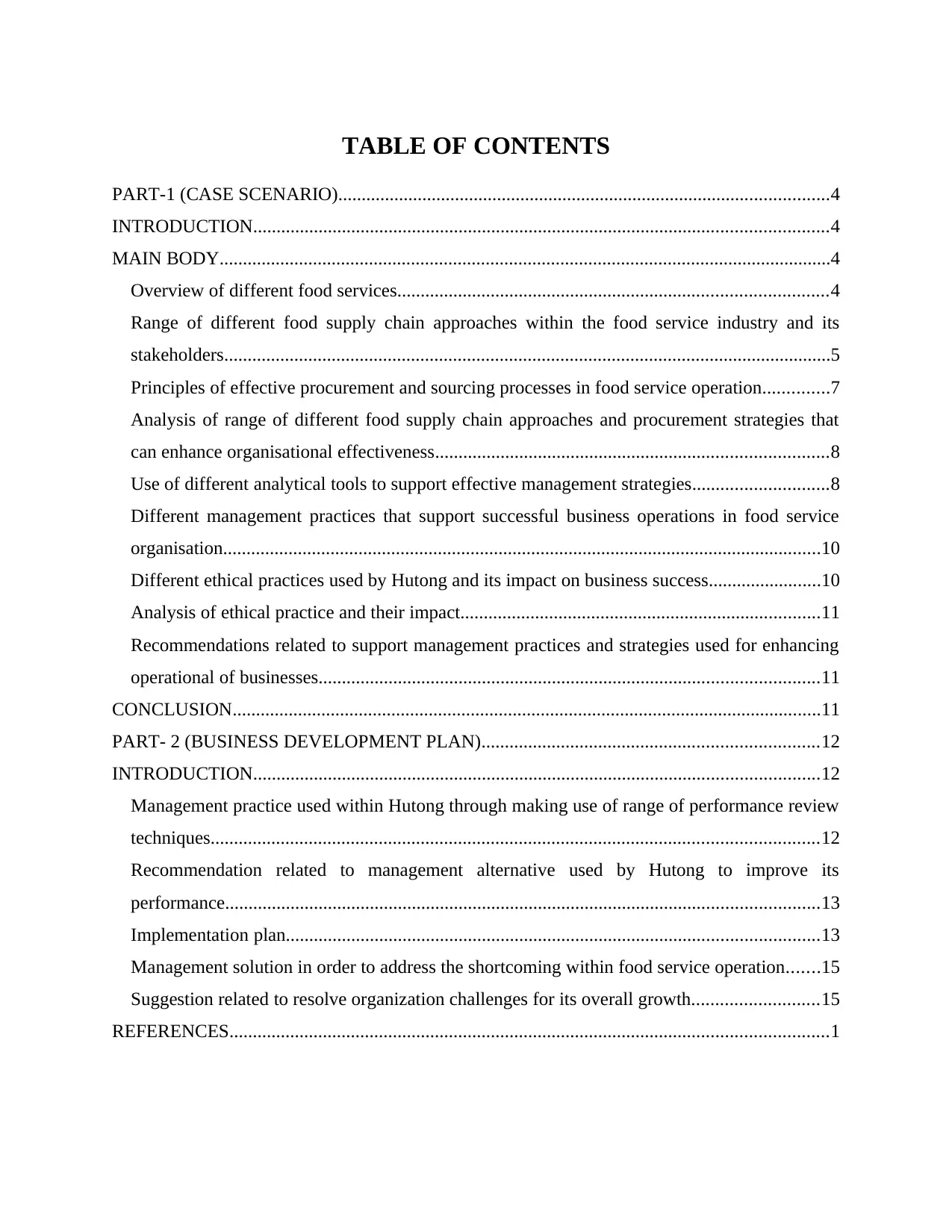
TABLE OF CONTENTS
PART-1 (CASE SCENARIO).........................................................................................................4
INTRODUCTION...........................................................................................................................4
MAIN BODY...................................................................................................................................4
Overview of different food services............................................................................................4
Range of different food supply chain approaches within the food service industry and its
stakeholders..................................................................................................................................5
Principles of effective procurement and sourcing processes in food service operation..............7
Analysis of range of different food supply chain approaches and procurement strategies that
can enhance organisational effectiveness....................................................................................8
Use of different analytical tools to support effective management strategies.............................8
Different management practices that support successful business operations in food service
organisation................................................................................................................................10
Different ethical practices used by Hutong and its impact on business success........................10
Analysis of ethical practice and their impact.............................................................................11
Recommendations related to support management practices and strategies used for enhancing
operational of businesses...........................................................................................................11
CONCLUSION..............................................................................................................................11
PART- 2 (BUSINESS DEVELOPMENT PLAN)........................................................................12
INTRODUCTION.........................................................................................................................12
Management practice used within Hutong through making use of range of performance review
techniques..................................................................................................................................12
Recommendation related to management alternative used by Hutong to improve its
performance...............................................................................................................................13
Implementation plan..................................................................................................................13
Management solution in order to address the shortcoming within food service operation.......15
Suggestion related to resolve organization challenges for its overall growth...........................15
REFERENCES................................................................................................................................1
PART-1 (CASE SCENARIO).........................................................................................................4
INTRODUCTION...........................................................................................................................4
MAIN BODY...................................................................................................................................4
Overview of different food services............................................................................................4
Range of different food supply chain approaches within the food service industry and its
stakeholders..................................................................................................................................5
Principles of effective procurement and sourcing processes in food service operation..............7
Analysis of range of different food supply chain approaches and procurement strategies that
can enhance organisational effectiveness....................................................................................8
Use of different analytical tools to support effective management strategies.............................8
Different management practices that support successful business operations in food service
organisation................................................................................................................................10
Different ethical practices used by Hutong and its impact on business success........................10
Analysis of ethical practice and their impact.............................................................................11
Recommendations related to support management practices and strategies used for enhancing
operational of businesses...........................................................................................................11
CONCLUSION..............................................................................................................................11
PART- 2 (BUSINESS DEVELOPMENT PLAN)........................................................................12
INTRODUCTION.........................................................................................................................12
Management practice used within Hutong through making use of range of performance review
techniques..................................................................................................................................12
Recommendation related to management alternative used by Hutong to improve its
performance...............................................................................................................................13
Implementation plan..................................................................................................................13
Management solution in order to address the shortcoming within food service operation.......15
Suggestion related to resolve organization challenges for its overall growth...........................15
REFERENCES................................................................................................................................1
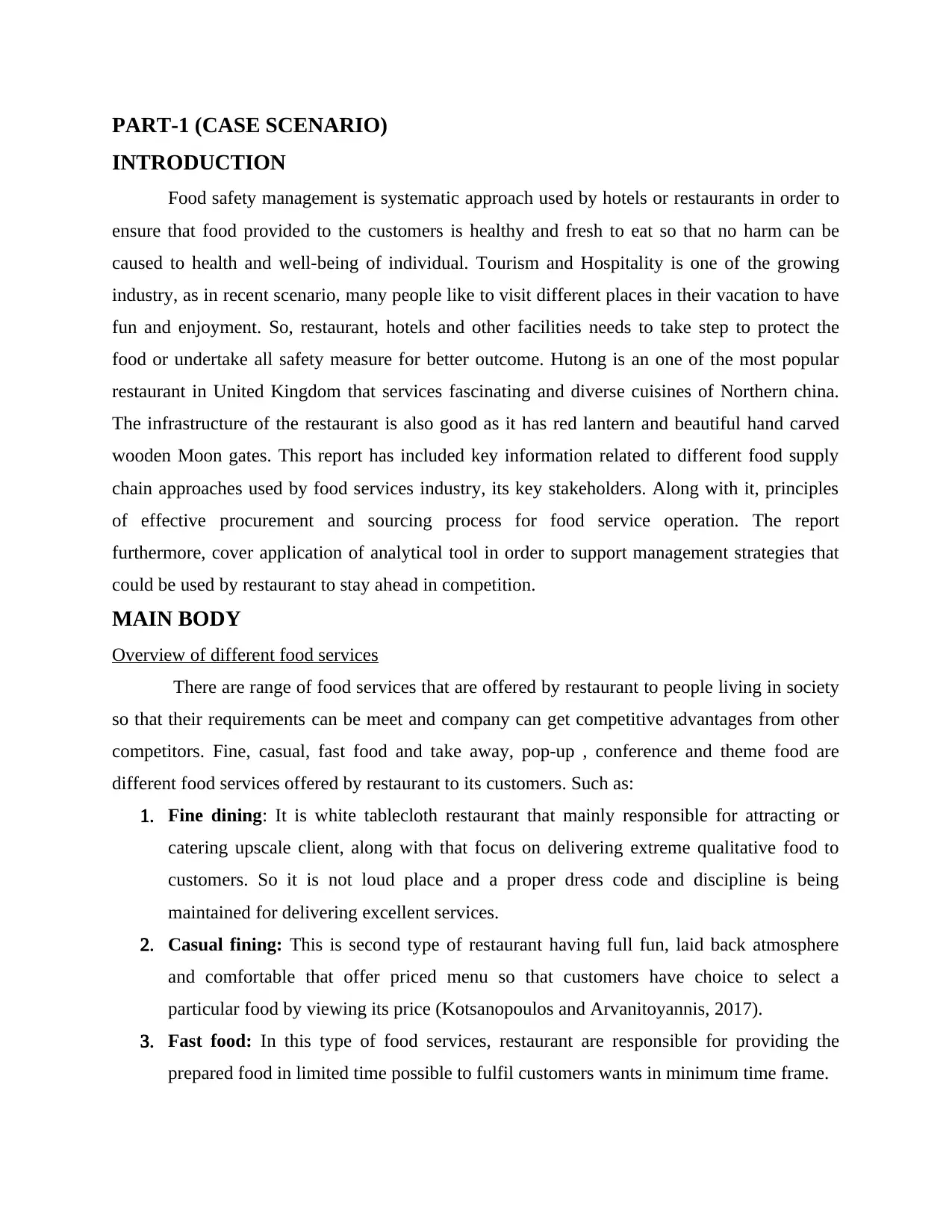
PART-1 (CASE SCENARIO)
INTRODUCTION
Food safety management is systematic approach used by hotels or restaurants in order to
ensure that food provided to the customers is healthy and fresh to eat so that no harm can be
caused to health and well-being of individual. Tourism and Hospitality is one of the growing
industry, as in recent scenario, many people like to visit different places in their vacation to have
fun and enjoyment. So, restaurant, hotels and other facilities needs to take step to protect the
food or undertake all safety measure for better outcome. Hutong is an one of the most popular
restaurant in United Kingdom that services fascinating and diverse cuisines of Northern china.
The infrastructure of the restaurant is also good as it has red lantern and beautiful hand carved
wooden Moon gates. This report has included key information related to different food supply
chain approaches used by food services industry, its key stakeholders. Along with it, principles
of effective procurement and sourcing process for food service operation. The report
furthermore, cover application of analytical tool in order to support management strategies that
could be used by restaurant to stay ahead in competition.
MAIN BODY
Overview of different food services
There are range of food services that are offered by restaurant to people living in society
so that their requirements can be meet and company can get competitive advantages from other
competitors. Fine, casual, fast food and take away, pop-up , conference and theme food are
different food services offered by restaurant to its customers. Such as:
1. Fine dining: It is white tablecloth restaurant that mainly responsible for attracting or
catering upscale client, along with that focus on delivering extreme qualitative food to
customers. So it is not loud place and a proper dress code and discipline is being
maintained for delivering excellent services.
2. Casual fining: This is second type of restaurant having full fun, laid back atmosphere
and comfortable that offer priced menu so that customers have choice to select a
particular food by viewing its price (Kotsanopoulos and Arvanitoyannis, 2017).
3. Fast food: In this type of food services, restaurant are responsible for providing the
prepared food in limited time possible to fulfil customers wants in minimum time frame.
INTRODUCTION
Food safety management is systematic approach used by hotels or restaurants in order to
ensure that food provided to the customers is healthy and fresh to eat so that no harm can be
caused to health and well-being of individual. Tourism and Hospitality is one of the growing
industry, as in recent scenario, many people like to visit different places in their vacation to have
fun and enjoyment. So, restaurant, hotels and other facilities needs to take step to protect the
food or undertake all safety measure for better outcome. Hutong is an one of the most popular
restaurant in United Kingdom that services fascinating and diverse cuisines of Northern china.
The infrastructure of the restaurant is also good as it has red lantern and beautiful hand carved
wooden Moon gates. This report has included key information related to different food supply
chain approaches used by food services industry, its key stakeholders. Along with it, principles
of effective procurement and sourcing process for food service operation. The report
furthermore, cover application of analytical tool in order to support management strategies that
could be used by restaurant to stay ahead in competition.
MAIN BODY
Overview of different food services
There are range of food services that are offered by restaurant to people living in society
so that their requirements can be meet and company can get competitive advantages from other
competitors. Fine, casual, fast food and take away, pop-up , conference and theme food are
different food services offered by restaurant to its customers. Such as:
1. Fine dining: It is white tablecloth restaurant that mainly responsible for attracting or
catering upscale client, along with that focus on delivering extreme qualitative food to
customers. So it is not loud place and a proper dress code and discipline is being
maintained for delivering excellent services.
2. Casual fining: This is second type of restaurant having full fun, laid back atmosphere
and comfortable that offer priced menu so that customers have choice to select a
particular food by viewing its price (Kotsanopoulos and Arvanitoyannis, 2017).
3. Fast food: In this type of food services, restaurant are responsible for providing the
prepared food in limited time possible to fulfil customers wants in minimum time frame.
⊘ This is a preview!⊘
Do you want full access?
Subscribe today to unlock all pages.

Trusted by 1+ million students worldwide
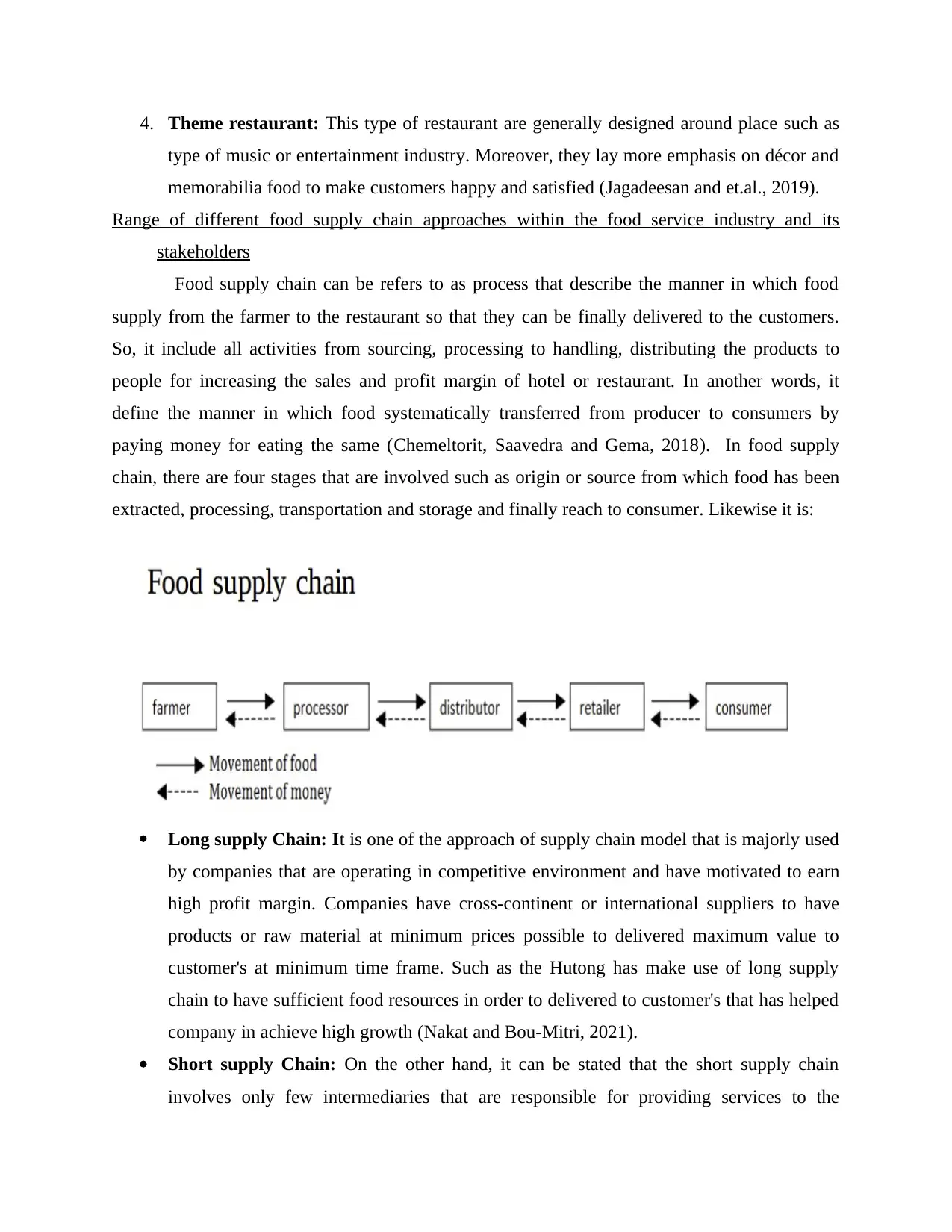
4. Theme restaurant: This type of restaurant are generally designed around place such as
type of music or entertainment industry. Moreover, they lay more emphasis on décor and
memorabilia food to make customers happy and satisfied (Jagadeesan and et.al., 2019).
Range of different food supply chain approaches within the food service industry and its
stakeholders
Food supply chain can be refers to as process that describe the manner in which food
supply from the farmer to the restaurant so that they can be finally delivered to the customers.
So, it include all activities from sourcing, processing to handling, distributing the products to
people for increasing the sales and profit margin of hotel or restaurant. In another words, it
define the manner in which food systematically transferred from producer to consumers by
paying money for eating the same (Chemeltorit, Saavedra and Gema, 2018). In food supply
chain, there are four stages that are involved such as origin or source from which food has been
extracted, processing, transportation and storage and finally reach to consumer. Likewise it is:
Long supply Chain: It is one of the approach of supply chain model that is majorly used
by companies that are operating in competitive environment and have motivated to earn
high profit margin. Companies have cross-continent or international suppliers to have
products or raw material at minimum prices possible to delivered maximum value to
customer's at minimum time frame. Such as the Hutong has make use of long supply
chain to have sufficient food resources in order to delivered to customer's that has helped
company in achieve high growth (Nakat and Bou-Mitri, 2021).
Short supply Chain: On the other hand, it can be stated that the short supply chain
involves only few intermediaries that are responsible for providing services to the
type of music or entertainment industry. Moreover, they lay more emphasis on décor and
memorabilia food to make customers happy and satisfied (Jagadeesan and et.al., 2019).
Range of different food supply chain approaches within the food service industry and its
stakeholders
Food supply chain can be refers to as process that describe the manner in which food
supply from the farmer to the restaurant so that they can be finally delivered to the customers.
So, it include all activities from sourcing, processing to handling, distributing the products to
people for increasing the sales and profit margin of hotel or restaurant. In another words, it
define the manner in which food systematically transferred from producer to consumers by
paying money for eating the same (Chemeltorit, Saavedra and Gema, 2018). In food supply
chain, there are four stages that are involved such as origin or source from which food has been
extracted, processing, transportation and storage and finally reach to consumer. Likewise it is:
Long supply Chain: It is one of the approach of supply chain model that is majorly used
by companies that are operating in competitive environment and have motivated to earn
high profit margin. Companies have cross-continent or international suppliers to have
products or raw material at minimum prices possible to delivered maximum value to
customer's at minimum time frame. Such as the Hutong has make use of long supply
chain to have sufficient food resources in order to delivered to customer's that has helped
company in achieve high growth (Nakat and Bou-Mitri, 2021).
Short supply Chain: On the other hand, it can be stated that the short supply chain
involves only few intermediaries that are responsible for providing services to the
Paraphrase This Document
Need a fresh take? Get an instant paraphrase of this document with our AI Paraphraser
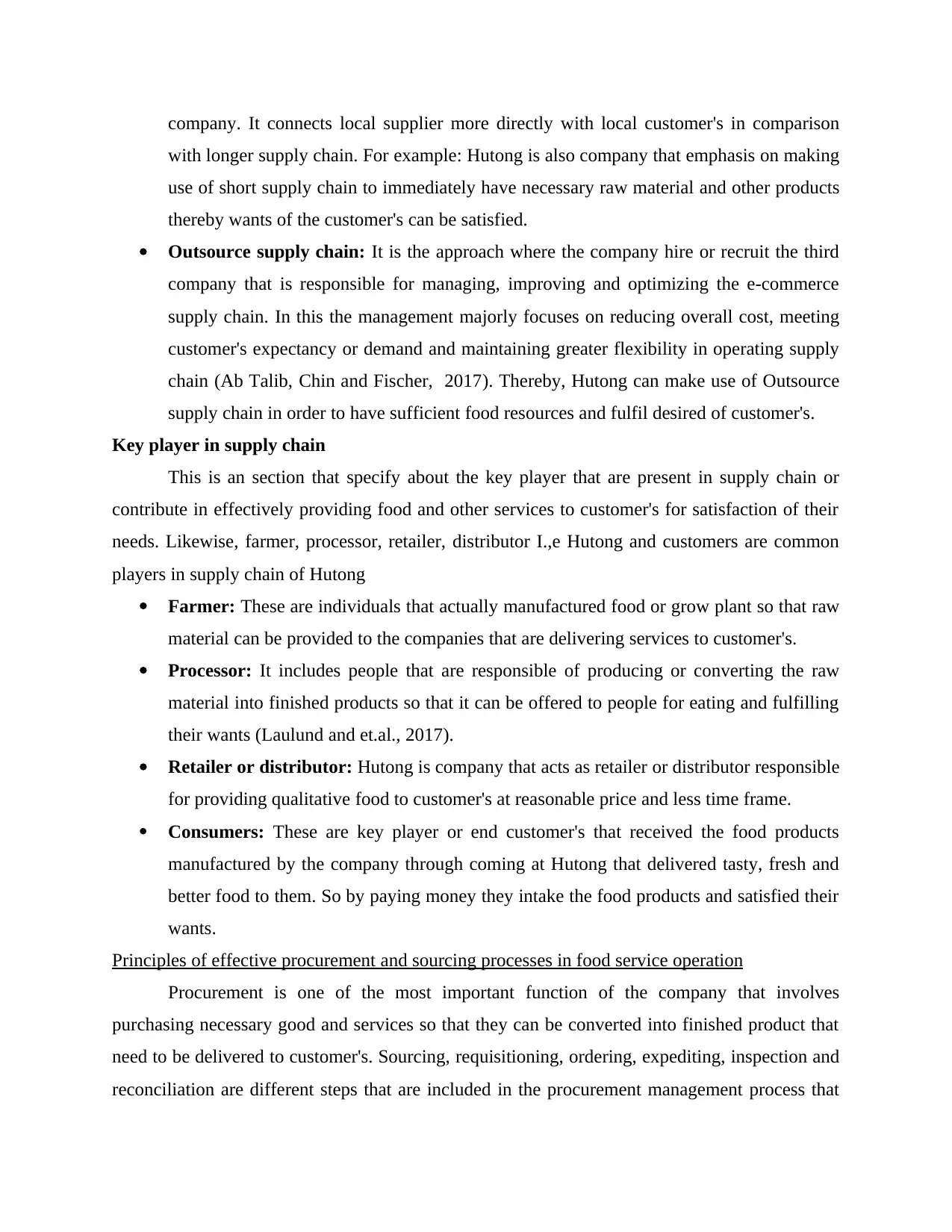
company. It connects local supplier more directly with local customer's in comparison
with longer supply chain. For example: Hutong is also company that emphasis on making
use of short supply chain to immediately have necessary raw material and other products
thereby wants of the customer's can be satisfied.
Outsource supply chain: It is the approach where the company hire or recruit the third
company that is responsible for managing, improving and optimizing the e-commerce
supply chain. In this the management majorly focuses on reducing overall cost, meeting
customer's expectancy or demand and maintaining greater flexibility in operating supply
chain (Ab Talib, Chin and Fischer, 2017). Thereby, Hutong can make use of Outsource
supply chain in order to have sufficient food resources and fulfil desired of customer's.
Key player in supply chain
This is an section that specify about the key player that are present in supply chain or
contribute in effectively providing food and other services to customer's for satisfaction of their
needs. Likewise, farmer, processor, retailer, distributor I.,e Hutong and customers are common
players in supply chain of Hutong
Farmer: These are individuals that actually manufactured food or grow plant so that raw
material can be provided to the companies that are delivering services to customer's.
Processor: It includes people that are responsible of producing or converting the raw
material into finished products so that it can be offered to people for eating and fulfilling
their wants (Laulund and et.al., 2017).
Retailer or distributor: Hutong is company that acts as retailer or distributor responsible
for providing qualitative food to customer's at reasonable price and less time frame.
Consumers: These are key player or end customer's that received the food products
manufactured by the company through coming at Hutong that delivered tasty, fresh and
better food to them. So by paying money they intake the food products and satisfied their
wants.
Principles of effective procurement and sourcing processes in food service operation
Procurement is one of the most important function of the company that involves
purchasing necessary good and services so that they can be converted into finished product that
need to be delivered to customer's. Sourcing, requisitioning, ordering, expediting, inspection and
reconciliation are different steps that are included in the procurement management process that
with longer supply chain. For example: Hutong is also company that emphasis on making
use of short supply chain to immediately have necessary raw material and other products
thereby wants of the customer's can be satisfied.
Outsource supply chain: It is the approach where the company hire or recruit the third
company that is responsible for managing, improving and optimizing the e-commerce
supply chain. In this the management majorly focuses on reducing overall cost, meeting
customer's expectancy or demand and maintaining greater flexibility in operating supply
chain (Ab Talib, Chin and Fischer, 2017). Thereby, Hutong can make use of Outsource
supply chain in order to have sufficient food resources and fulfil desired of customer's.
Key player in supply chain
This is an section that specify about the key player that are present in supply chain or
contribute in effectively providing food and other services to customer's for satisfaction of their
needs. Likewise, farmer, processor, retailer, distributor I.,e Hutong and customers are common
players in supply chain of Hutong
Farmer: These are individuals that actually manufactured food or grow plant so that raw
material can be provided to the companies that are delivering services to customer's.
Processor: It includes people that are responsible of producing or converting the raw
material into finished products so that it can be offered to people for eating and fulfilling
their wants (Laulund and et.al., 2017).
Retailer or distributor: Hutong is company that acts as retailer or distributor responsible
for providing qualitative food to customer's at reasonable price and less time frame.
Consumers: These are key player or end customer's that received the food products
manufactured by the company through coming at Hutong that delivered tasty, fresh and
better food to them. So by paying money they intake the food products and satisfied their
wants.
Principles of effective procurement and sourcing processes in food service operation
Procurement is one of the most important function of the company that involves
purchasing necessary good and services so that they can be converted into finished product that
need to be delivered to customer's. Sourcing, requisitioning, ordering, expediting, inspection and
reconciliation are different steps that are included in the procurement management process that
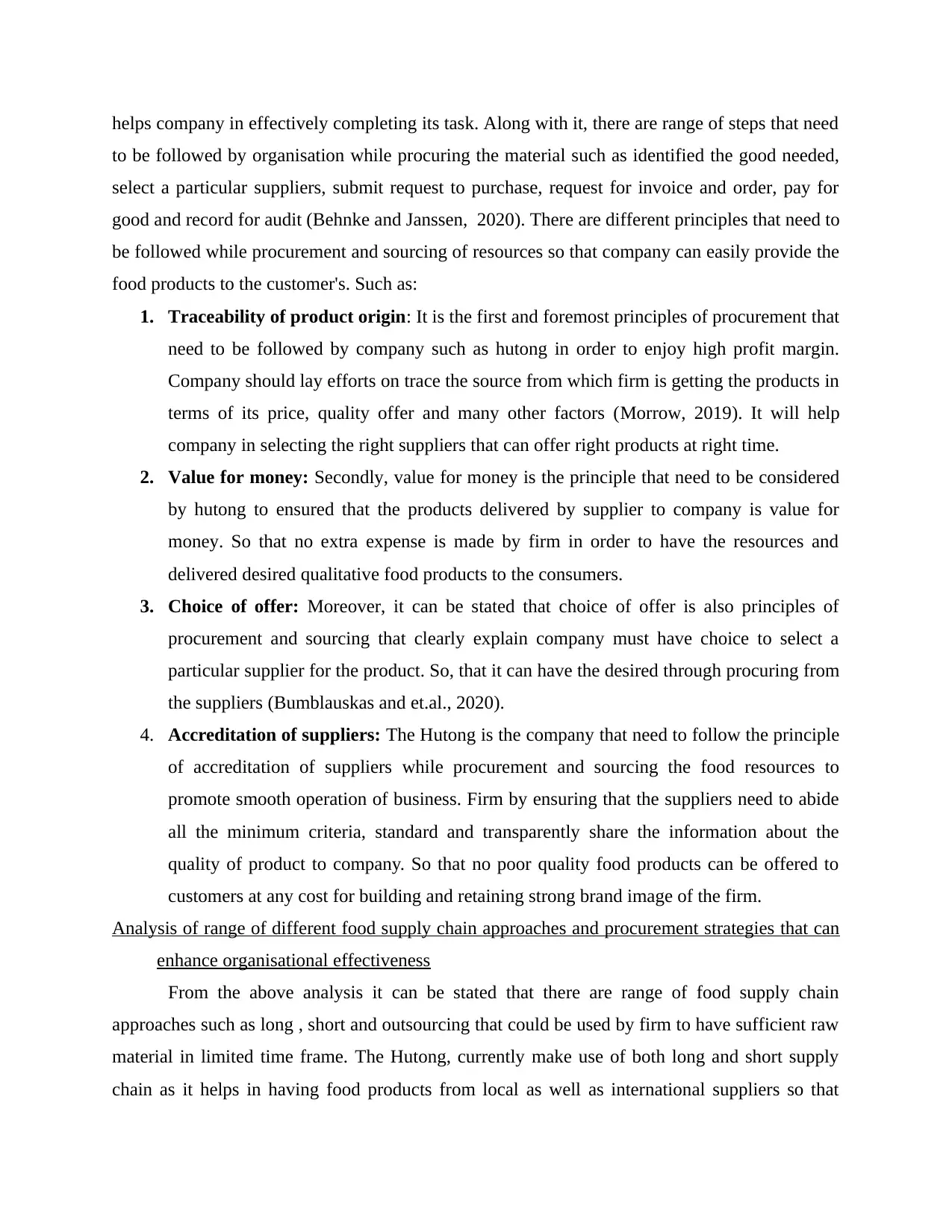
helps company in effectively completing its task. Along with it, there are range of steps that need
to be followed by organisation while procuring the material such as identified the good needed,
select a particular suppliers, submit request to purchase, request for invoice and order, pay for
good and record for audit (Behnke and Janssen, 2020). There are different principles that need to
be followed while procurement and sourcing of resources so that company can easily provide the
food products to the customer's. Such as:
1. Traceability of product origin: It is the first and foremost principles of procurement that
need to be followed by company such as hutong in order to enjoy high profit margin.
Company should lay efforts on trace the source from which firm is getting the products in
terms of its price, quality offer and many other factors (Morrow, 2019). It will help
company in selecting the right suppliers that can offer right products at right time.
2. Value for money: Secondly, value for money is the principle that need to be considered
by hutong to ensured that the products delivered by supplier to company is value for
money. So that no extra expense is made by firm in order to have the resources and
delivered desired qualitative food products to the consumers.
3. Choice of offer: Moreover, it can be stated that choice of offer is also principles of
procurement and sourcing that clearly explain company must have choice to select a
particular supplier for the product. So, that it can have the desired through procuring from
the suppliers (Bumblauskas and et.al., 2020).
4. Accreditation of suppliers: The Hutong is the company that need to follow the principle
of accreditation of suppliers while procurement and sourcing the food resources to
promote smooth operation of business. Firm by ensuring that the suppliers need to abide
all the minimum criteria, standard and transparently share the information about the
quality of product to company. So that no poor quality food products can be offered to
customers at any cost for building and retaining strong brand image of the firm.
Analysis of range of different food supply chain approaches and procurement strategies that can
enhance organisational effectiveness
From the above analysis it can be stated that there are range of food supply chain
approaches such as long , short and outsourcing that could be used by firm to have sufficient raw
material in limited time frame. The Hutong, currently make use of both long and short supply
chain as it helps in having food products from local as well as international suppliers so that
to be followed by organisation while procuring the material such as identified the good needed,
select a particular suppliers, submit request to purchase, request for invoice and order, pay for
good and record for audit (Behnke and Janssen, 2020). There are different principles that need to
be followed while procurement and sourcing of resources so that company can easily provide the
food products to the customer's. Such as:
1. Traceability of product origin: It is the first and foremost principles of procurement that
need to be followed by company such as hutong in order to enjoy high profit margin.
Company should lay efforts on trace the source from which firm is getting the products in
terms of its price, quality offer and many other factors (Morrow, 2019). It will help
company in selecting the right suppliers that can offer right products at right time.
2. Value for money: Secondly, value for money is the principle that need to be considered
by hutong to ensured that the products delivered by supplier to company is value for
money. So that no extra expense is made by firm in order to have the resources and
delivered desired qualitative food products to the consumers.
3. Choice of offer: Moreover, it can be stated that choice of offer is also principles of
procurement and sourcing that clearly explain company must have choice to select a
particular supplier for the product. So, that it can have the desired through procuring from
the suppliers (Bumblauskas and et.al., 2020).
4. Accreditation of suppliers: The Hutong is the company that need to follow the principle
of accreditation of suppliers while procurement and sourcing the food resources to
promote smooth operation of business. Firm by ensuring that the suppliers need to abide
all the minimum criteria, standard and transparently share the information about the
quality of product to company. So that no poor quality food products can be offered to
customers at any cost for building and retaining strong brand image of the firm.
Analysis of range of different food supply chain approaches and procurement strategies that can
enhance organisational effectiveness
From the above analysis it can be stated that there are range of food supply chain
approaches such as long , short and outsourcing that could be used by firm to have sufficient raw
material in limited time frame. The Hutong, currently make use of both long and short supply
chain as it helps in having food products from local as well as international suppliers so that
⊘ This is a preview!⊘
Do you want full access?
Subscribe today to unlock all pages.

Trusted by 1+ million students worldwide
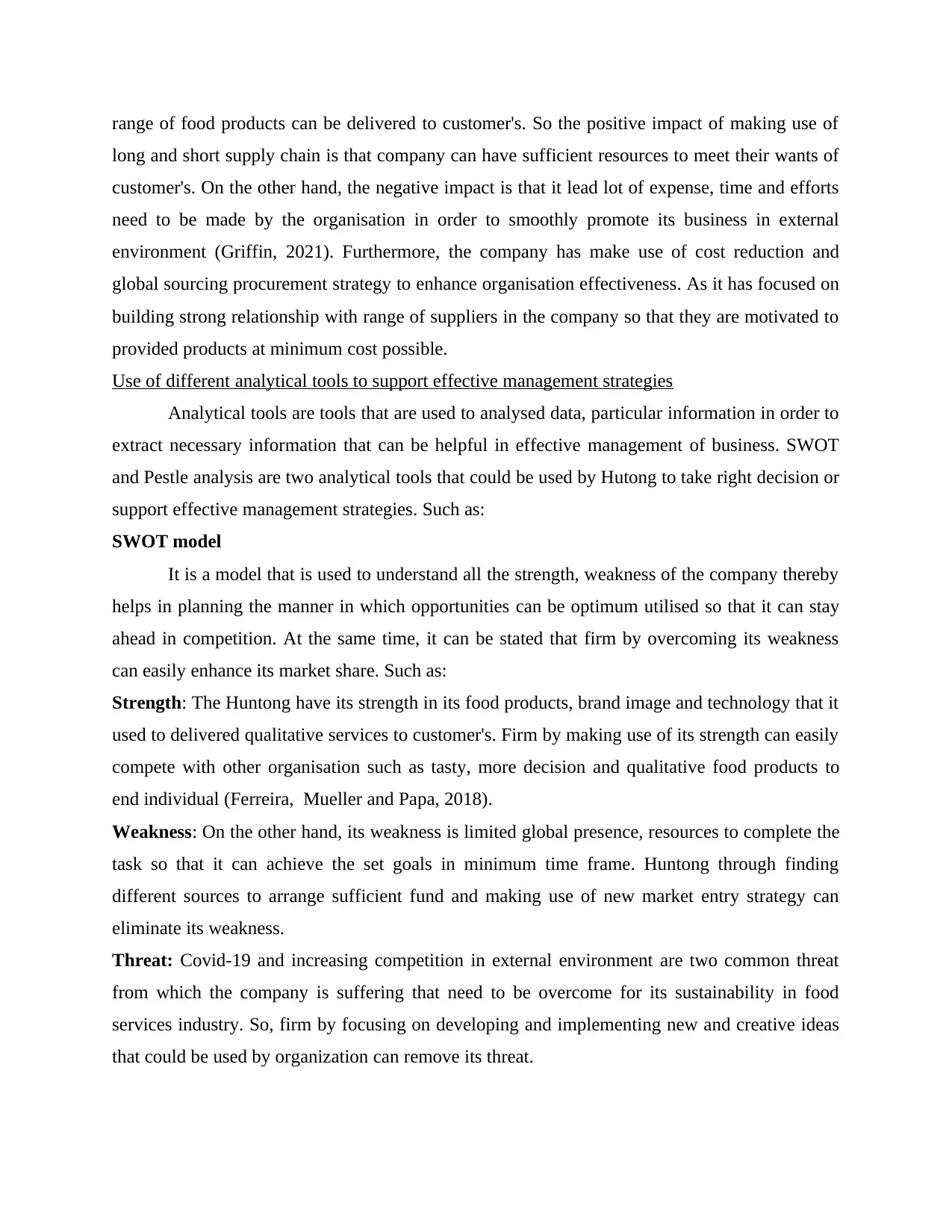
range of food products can be delivered to customer's. So the positive impact of making use of
long and short supply chain is that company can have sufficient resources to meet their wants of
customer's. On the other hand, the negative impact is that it lead lot of expense, time and efforts
need to be made by the organisation in order to smoothly promote its business in external
environment (Griffin, 2021). Furthermore, the company has make use of cost reduction and
global sourcing procurement strategy to enhance organisation effectiveness. As it has focused on
building strong relationship with range of suppliers in the company so that they are motivated to
provided products at minimum cost possible.
Use of different analytical tools to support effective management strategies
Analytical tools are tools that are used to analysed data, particular information in order to
extract necessary information that can be helpful in effective management of business. SWOT
and Pestle analysis are two analytical tools that could be used by Hutong to take right decision or
support effective management strategies. Such as:
SWOT model
It is a model that is used to understand all the strength, weakness of the company thereby
helps in planning the manner in which opportunities can be optimum utilised so that it can stay
ahead in competition. At the same time, it can be stated that firm by overcoming its weakness
can easily enhance its market share. Such as:
Strength: The Huntong have its strength in its food products, brand image and technology that it
used to delivered qualitative services to customer's. Firm by making use of its strength can easily
compete with other organisation such as tasty, more decision and qualitative food products to
end individual (Ferreira, Mueller and Papa, 2018).
Weakness: On the other hand, its weakness is limited global presence, resources to complete the
task so that it can achieve the set goals in minimum time frame. Huntong through finding
different sources to arrange sufficient fund and making use of new market entry strategy can
eliminate its weakness.
Threat: Covid-19 and increasing competition in external environment are two common threat
from which the company is suffering that need to be overcome for its sustainability in food
services industry. So, firm by focusing on developing and implementing new and creative ideas
that could be used by organization can remove its threat.
long and short supply chain is that company can have sufficient resources to meet their wants of
customer's. On the other hand, the negative impact is that it lead lot of expense, time and efforts
need to be made by the organisation in order to smoothly promote its business in external
environment (Griffin, 2021). Furthermore, the company has make use of cost reduction and
global sourcing procurement strategy to enhance organisation effectiveness. As it has focused on
building strong relationship with range of suppliers in the company so that they are motivated to
provided products at minimum cost possible.
Use of different analytical tools to support effective management strategies
Analytical tools are tools that are used to analysed data, particular information in order to
extract necessary information that can be helpful in effective management of business. SWOT
and Pestle analysis are two analytical tools that could be used by Hutong to take right decision or
support effective management strategies. Such as:
SWOT model
It is a model that is used to understand all the strength, weakness of the company thereby
helps in planning the manner in which opportunities can be optimum utilised so that it can stay
ahead in competition. At the same time, it can be stated that firm by overcoming its weakness
can easily enhance its market share. Such as:
Strength: The Huntong have its strength in its food products, brand image and technology that it
used to delivered qualitative services to customer's. Firm by making use of its strength can easily
compete with other organisation such as tasty, more decision and qualitative food products to
end individual (Ferreira, Mueller and Papa, 2018).
Weakness: On the other hand, its weakness is limited global presence, resources to complete the
task so that it can achieve the set goals in minimum time frame. Huntong through finding
different sources to arrange sufficient fund and making use of new market entry strategy can
eliminate its weakness.
Threat: Covid-19 and increasing competition in external environment are two common threat
from which the company is suffering that need to be overcome for its sustainability in food
services industry. So, firm by focusing on developing and implementing new and creative ideas
that could be used by organization can remove its threat.
Paraphrase This Document
Need a fresh take? Get an instant paraphrase of this document with our AI Paraphraser
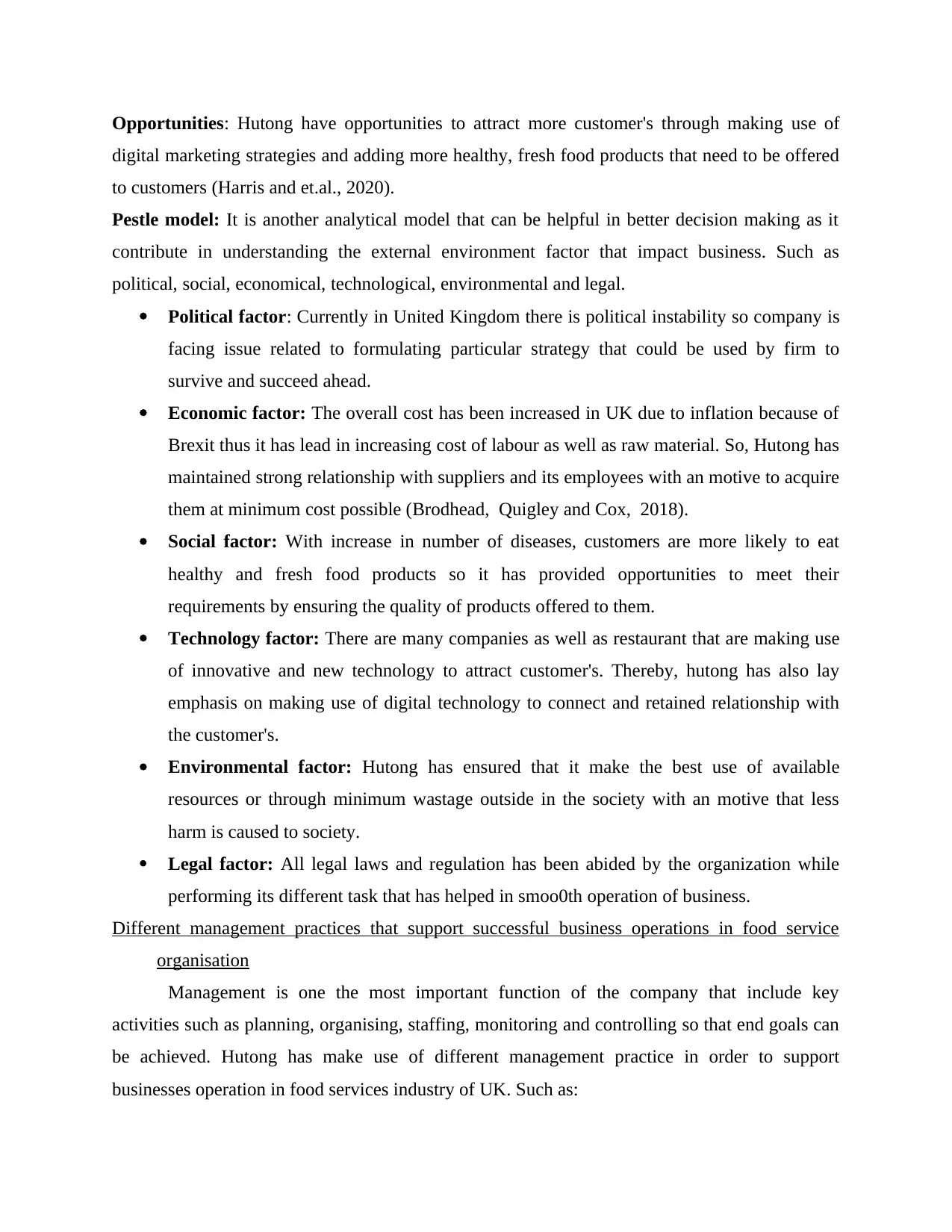
Opportunities: Hutong have opportunities to attract more customer's through making use of
digital marketing strategies and adding more healthy, fresh food products that need to be offered
to customers (Harris and et.al., 2020).
Pestle model: It is another analytical model that can be helpful in better decision making as it
contribute in understanding the external environment factor that impact business. Such as
political, social, economical, technological, environmental and legal.
Political factor: Currently in United Kingdom there is political instability so company is
facing issue related to formulating particular strategy that could be used by firm to
survive and succeed ahead.
Economic factor: The overall cost has been increased in UK due to inflation because of
Brexit thus it has lead in increasing cost of labour as well as raw material. So, Hutong has
maintained strong relationship with suppliers and its employees with an motive to acquire
them at minimum cost possible (Brodhead, Quigley and Cox, 2018).
Social factor: With increase in number of diseases, customers are more likely to eat
healthy and fresh food products so it has provided opportunities to meet their
requirements by ensuring the quality of products offered to them.
Technology factor: There are many companies as well as restaurant that are making use
of innovative and new technology to attract customer's. Thereby, hutong has also lay
emphasis on making use of digital technology to connect and retained relationship with
the customer's.
Environmental factor: Hutong has ensured that it make the best use of available
resources or through minimum wastage outside in the society with an motive that less
harm is caused to society.
Legal factor: All legal laws and regulation has been abided by the organization while
performing its different task that has helped in smoo0th operation of business.
Different management practices that support successful business operations in food service
organisation
Management is one the most important function of the company that include key
activities such as planning, organising, staffing, monitoring and controlling so that end goals can
be achieved. Hutong has make use of different management practice in order to support
businesses operation in food services industry of UK. Such as:
digital marketing strategies and adding more healthy, fresh food products that need to be offered
to customers (Harris and et.al., 2020).
Pestle model: It is another analytical model that can be helpful in better decision making as it
contribute in understanding the external environment factor that impact business. Such as
political, social, economical, technological, environmental and legal.
Political factor: Currently in United Kingdom there is political instability so company is
facing issue related to formulating particular strategy that could be used by firm to
survive and succeed ahead.
Economic factor: The overall cost has been increased in UK due to inflation because of
Brexit thus it has lead in increasing cost of labour as well as raw material. So, Hutong has
maintained strong relationship with suppliers and its employees with an motive to acquire
them at minimum cost possible (Brodhead, Quigley and Cox, 2018).
Social factor: With increase in number of diseases, customers are more likely to eat
healthy and fresh food products so it has provided opportunities to meet their
requirements by ensuring the quality of products offered to them.
Technology factor: There are many companies as well as restaurant that are making use
of innovative and new technology to attract customer's. Thereby, hutong has also lay
emphasis on making use of digital technology to connect and retained relationship with
the customer's.
Environmental factor: Hutong has ensured that it make the best use of available
resources or through minimum wastage outside in the society with an motive that less
harm is caused to society.
Legal factor: All legal laws and regulation has been abided by the organization while
performing its different task that has helped in smoo0th operation of business.
Different management practices that support successful business operations in food service
organisation
Management is one the most important function of the company that include key
activities such as planning, organising, staffing, monitoring and controlling so that end goals can
be achieved. Hutong has make use of different management practice in order to support
businesses operation in food services industry of UK. Such as:
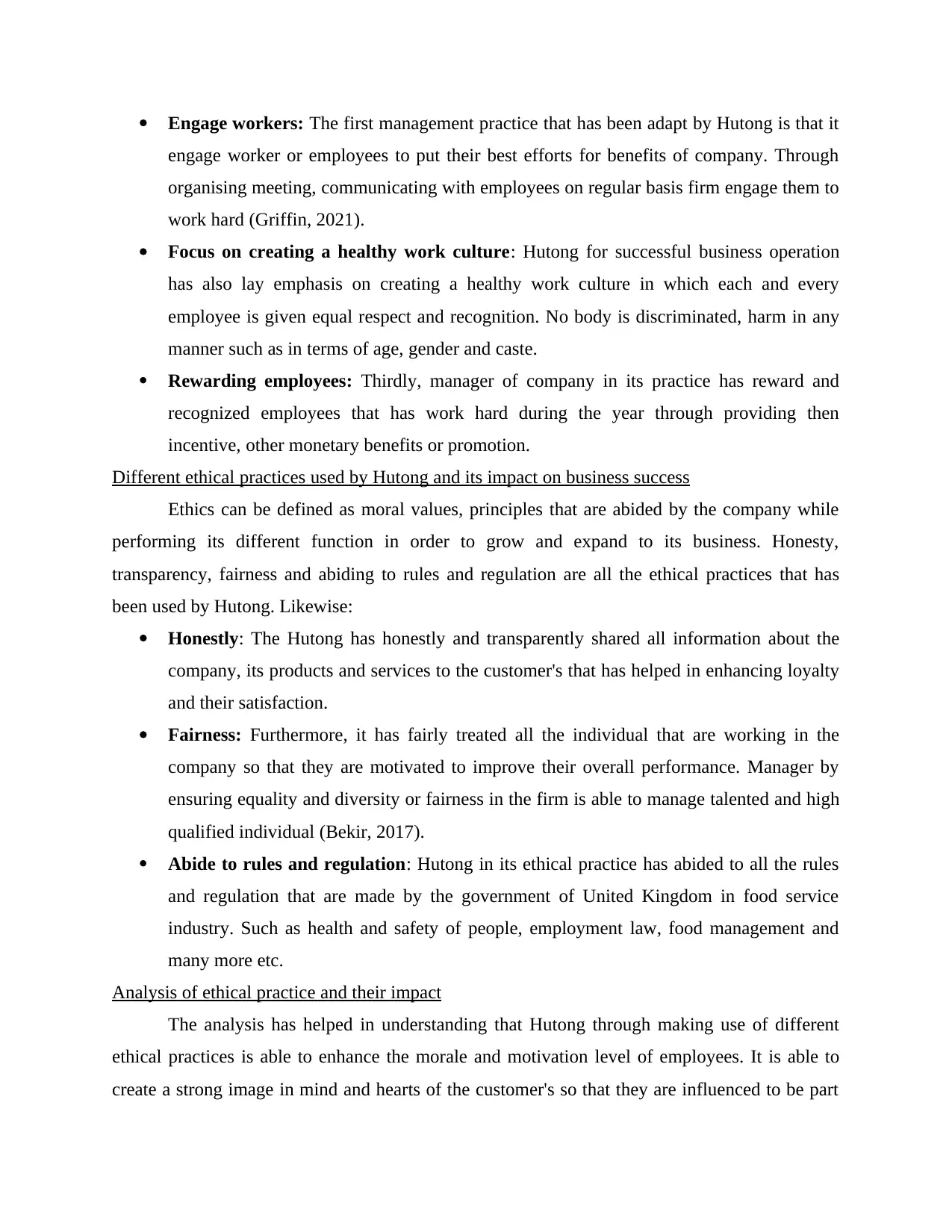
Engage workers: The first management practice that has been adapt by Hutong is that it
engage worker or employees to put their best efforts for benefits of company. Through
organising meeting, communicating with employees on regular basis firm engage them to
work hard (Griffin, 2021).
Focus on creating a healthy work culture: Hutong for successful business operation
has also lay emphasis on creating a healthy work culture in which each and every
employee is given equal respect and recognition. No body is discriminated, harm in any
manner such as in terms of age, gender and caste.
Rewarding employees: Thirdly, manager of company in its practice has reward and
recognized employees that has work hard during the year through providing then
incentive, other monetary benefits or promotion.
Different ethical practices used by Hutong and its impact on business success
Ethics can be defined as moral values, principles that are abided by the company while
performing its different function in order to grow and expand to its business. Honesty,
transparency, fairness and abiding to rules and regulation are all the ethical practices that has
been used by Hutong. Likewise:
Honestly: The Hutong has honestly and transparently shared all information about the
company, its products and services to the customer's that has helped in enhancing loyalty
and their satisfaction.
Fairness: Furthermore, it has fairly treated all the individual that are working in the
company so that they are motivated to improve their overall performance. Manager by
ensuring equality and diversity or fairness in the firm is able to manage talented and high
qualified individual (Bekir, 2017).
Abide to rules and regulation: Hutong in its ethical practice has abided to all the rules
and regulation that are made by the government of United Kingdom in food service
industry. Such as health and safety of people, employment law, food management and
many more etc.
Analysis of ethical practice and their impact
The analysis has helped in understanding that Hutong through making use of different
ethical practices is able to enhance the morale and motivation level of employees. It is able to
create a strong image in mind and hearts of the customer's so that they are influenced to be part
engage worker or employees to put their best efforts for benefits of company. Through
organising meeting, communicating with employees on regular basis firm engage them to
work hard (Griffin, 2021).
Focus on creating a healthy work culture: Hutong for successful business operation
has also lay emphasis on creating a healthy work culture in which each and every
employee is given equal respect and recognition. No body is discriminated, harm in any
manner such as in terms of age, gender and caste.
Rewarding employees: Thirdly, manager of company in its practice has reward and
recognized employees that has work hard during the year through providing then
incentive, other monetary benefits or promotion.
Different ethical practices used by Hutong and its impact on business success
Ethics can be defined as moral values, principles that are abided by the company while
performing its different function in order to grow and expand to its business. Honesty,
transparency, fairness and abiding to rules and regulation are all the ethical practices that has
been used by Hutong. Likewise:
Honestly: The Hutong has honestly and transparently shared all information about the
company, its products and services to the customer's that has helped in enhancing loyalty
and their satisfaction.
Fairness: Furthermore, it has fairly treated all the individual that are working in the
company so that they are motivated to improve their overall performance. Manager by
ensuring equality and diversity or fairness in the firm is able to manage talented and high
qualified individual (Bekir, 2017).
Abide to rules and regulation: Hutong in its ethical practice has abided to all the rules
and regulation that are made by the government of United Kingdom in food service
industry. Such as health and safety of people, employment law, food management and
many more etc.
Analysis of ethical practice and their impact
The analysis has helped in understanding that Hutong through making use of different
ethical practices is able to enhance the morale and motivation level of employees. It is able to
create a strong image in mind and hearts of the customer's so that they are influenced to be part
⊘ This is a preview!⊘
Do you want full access?
Subscribe today to unlock all pages.

Trusted by 1+ million students worldwide
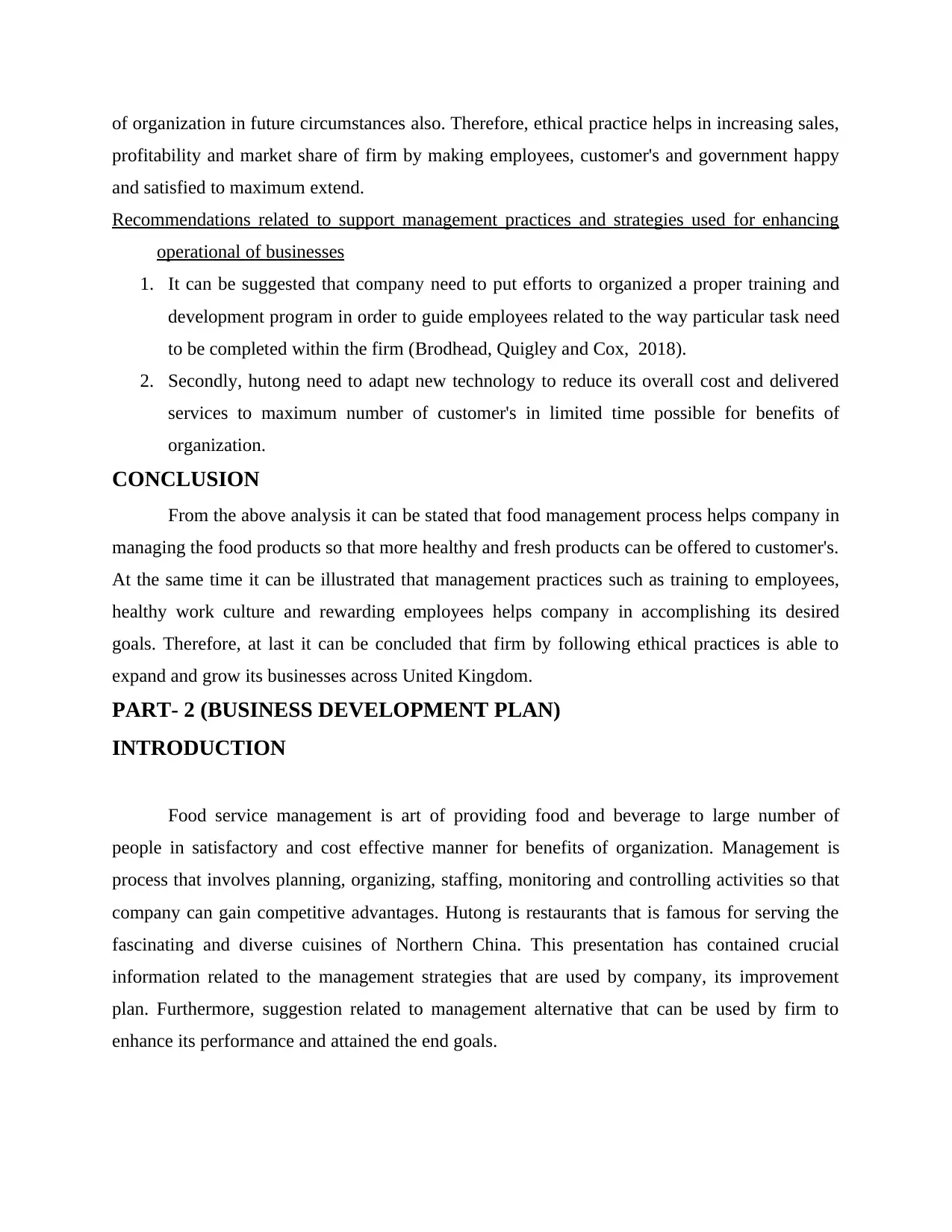
of organization in future circumstances also. Therefore, ethical practice helps in increasing sales,
profitability and market share of firm by making employees, customer's and government happy
and satisfied to maximum extend.
Recommendations related to support management practices and strategies used for enhancing
operational of businesses
1. It can be suggested that company need to put efforts to organized a proper training and
development program in order to guide employees related to the way particular task need
to be completed within the firm (Brodhead, Quigley and Cox, 2018).
2. Secondly, hutong need to adapt new technology to reduce its overall cost and delivered
services to maximum number of customer's in limited time possible for benefits of
organization.
CONCLUSION
From the above analysis it can be stated that food management process helps company in
managing the food products so that more healthy and fresh products can be offered to customer's.
At the same time it can be illustrated that management practices such as training to employees,
healthy work culture and rewarding employees helps company in accomplishing its desired
goals. Therefore, at last it can be concluded that firm by following ethical practices is able to
expand and grow its businesses across United Kingdom.
PART- 2 (BUSINESS DEVELOPMENT PLAN)
INTRODUCTION
Food service management is art of providing food and beverage to large number of
people in satisfactory and cost effective manner for benefits of organization. Management is
process that involves planning, organizing, staffing, monitoring and controlling activities so that
company can gain competitive advantages. Hutong is restaurants that is famous for serving the
fascinating and diverse cuisines of Northern China. This presentation has contained crucial
information related to the management strategies that are used by company, its improvement
plan. Furthermore, suggestion related to management alternative that can be used by firm to
enhance its performance and attained the end goals.
profitability and market share of firm by making employees, customer's and government happy
and satisfied to maximum extend.
Recommendations related to support management practices and strategies used for enhancing
operational of businesses
1. It can be suggested that company need to put efforts to organized a proper training and
development program in order to guide employees related to the way particular task need
to be completed within the firm (Brodhead, Quigley and Cox, 2018).
2. Secondly, hutong need to adapt new technology to reduce its overall cost and delivered
services to maximum number of customer's in limited time possible for benefits of
organization.
CONCLUSION
From the above analysis it can be stated that food management process helps company in
managing the food products so that more healthy and fresh products can be offered to customer's.
At the same time it can be illustrated that management practices such as training to employees,
healthy work culture and rewarding employees helps company in accomplishing its desired
goals. Therefore, at last it can be concluded that firm by following ethical practices is able to
expand and grow its businesses across United Kingdom.
PART- 2 (BUSINESS DEVELOPMENT PLAN)
INTRODUCTION
Food service management is art of providing food and beverage to large number of
people in satisfactory and cost effective manner for benefits of organization. Management is
process that involves planning, organizing, staffing, monitoring and controlling activities so that
company can gain competitive advantages. Hutong is restaurants that is famous for serving the
fascinating and diverse cuisines of Northern China. This presentation has contained crucial
information related to the management strategies that are used by company, its improvement
plan. Furthermore, suggestion related to management alternative that can be used by firm to
enhance its performance and attained the end goals.
Paraphrase This Document
Need a fresh take? Get an instant paraphrase of this document with our AI Paraphraser
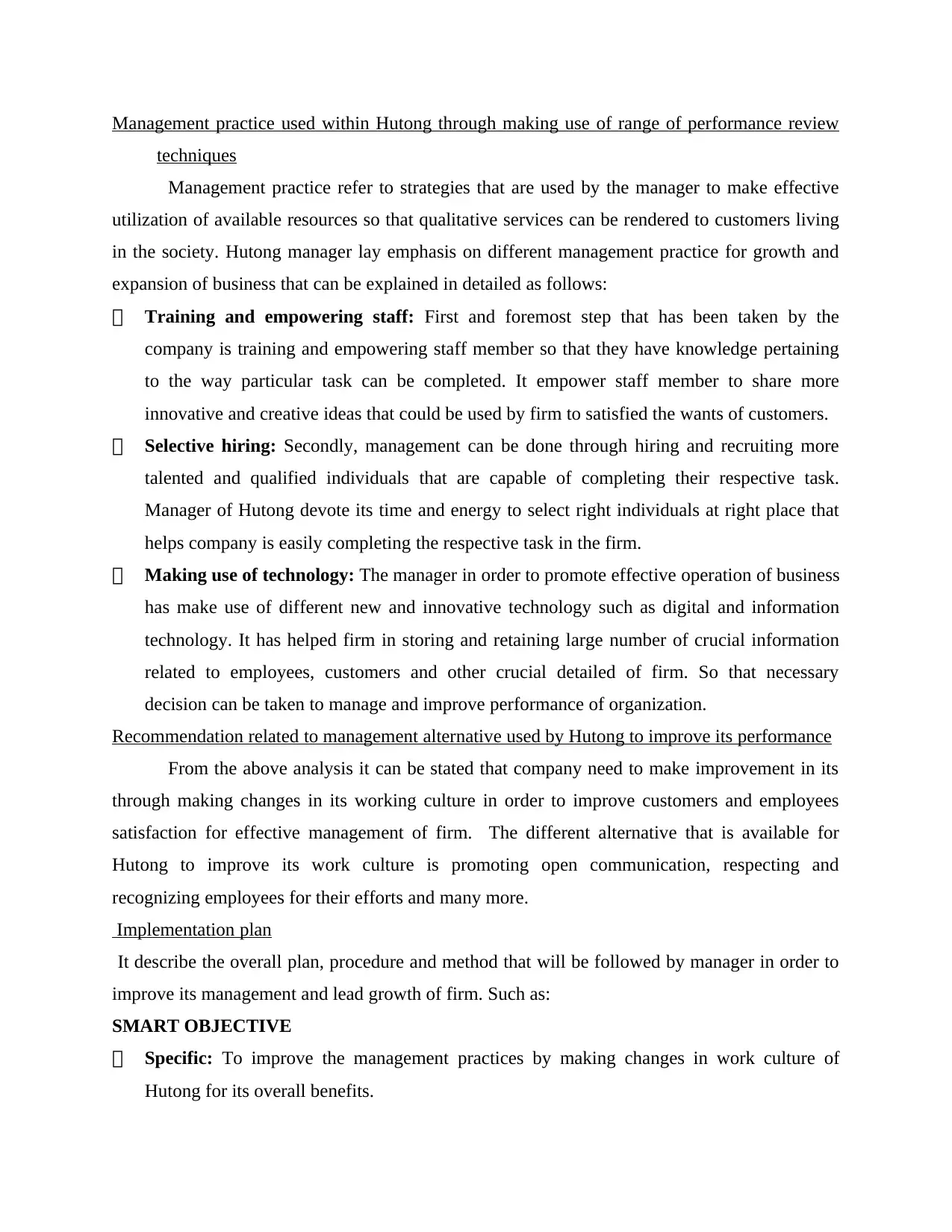
Management practice used within Hutong through making use of range of performance review
techniques
Management practice refer to strategies that are used by the manager to make effective
utilization of available resources so that qualitative services can be rendered to customers living
in the society. Hutong manager lay emphasis on different management practice for growth and
expansion of business that can be explained in detailed as follows:
Training and empowering staff: First and foremost step that has been taken by the
company is training and empowering staff member so that they have knowledge pertaining
to the way particular task can be completed. It empower staff member to share more
innovative and creative ideas that could be used by firm to satisfied the wants of customers.
Selective hiring: Secondly, management can be done through hiring and recruiting more
talented and qualified individuals that are capable of completing their respective task.
Manager of Hutong devote its time and energy to select right individuals at right place that
helps company is easily completing the respective task in the firm.
Making use of technology: The manager in order to promote effective operation of business
has make use of different new and innovative technology such as digital and information
technology. It has helped firm in storing and retaining large number of crucial information
related to employees, customers and other crucial detailed of firm. So that necessary
decision can be taken to manage and improve performance of organization.
Recommendation related to management alternative used by Hutong to improve its performance
From the above analysis it can be stated that company need to make improvement in its
through making changes in its working culture in order to improve customers and employees
satisfaction for effective management of firm. The different alternative that is available for
Hutong to improve its work culture is promoting open communication, respecting and
recognizing employees for their efforts and many more.
Implementation plan
It describe the overall plan, procedure and method that will be followed by manager in order to
improve its management and lead growth of firm. Such as:
SMART OBJECTIVE
Specific: To improve the management practices by making changes in work culture of
Hutong for its overall benefits.
techniques
Management practice refer to strategies that are used by the manager to make effective
utilization of available resources so that qualitative services can be rendered to customers living
in the society. Hutong manager lay emphasis on different management practice for growth and
expansion of business that can be explained in detailed as follows:
Training and empowering staff: First and foremost step that has been taken by the
company is training and empowering staff member so that they have knowledge pertaining
to the way particular task can be completed. It empower staff member to share more
innovative and creative ideas that could be used by firm to satisfied the wants of customers.
Selective hiring: Secondly, management can be done through hiring and recruiting more
talented and qualified individuals that are capable of completing their respective task.
Manager of Hutong devote its time and energy to select right individuals at right place that
helps company is easily completing the respective task in the firm.
Making use of technology: The manager in order to promote effective operation of business
has make use of different new and innovative technology such as digital and information
technology. It has helped firm in storing and retaining large number of crucial information
related to employees, customers and other crucial detailed of firm. So that necessary
decision can be taken to manage and improve performance of organization.
Recommendation related to management alternative used by Hutong to improve its performance
From the above analysis it can be stated that company need to make improvement in its
through making changes in its working culture in order to improve customers and employees
satisfaction for effective management of firm. The different alternative that is available for
Hutong to improve its work culture is promoting open communication, respecting and
recognizing employees for their efforts and many more.
Implementation plan
It describe the overall plan, procedure and method that will be followed by manager in order to
improve its management and lead growth of firm. Such as:
SMART OBJECTIVE
Specific: To improve the management practices by making changes in work culture of
Hutong for its overall benefits.
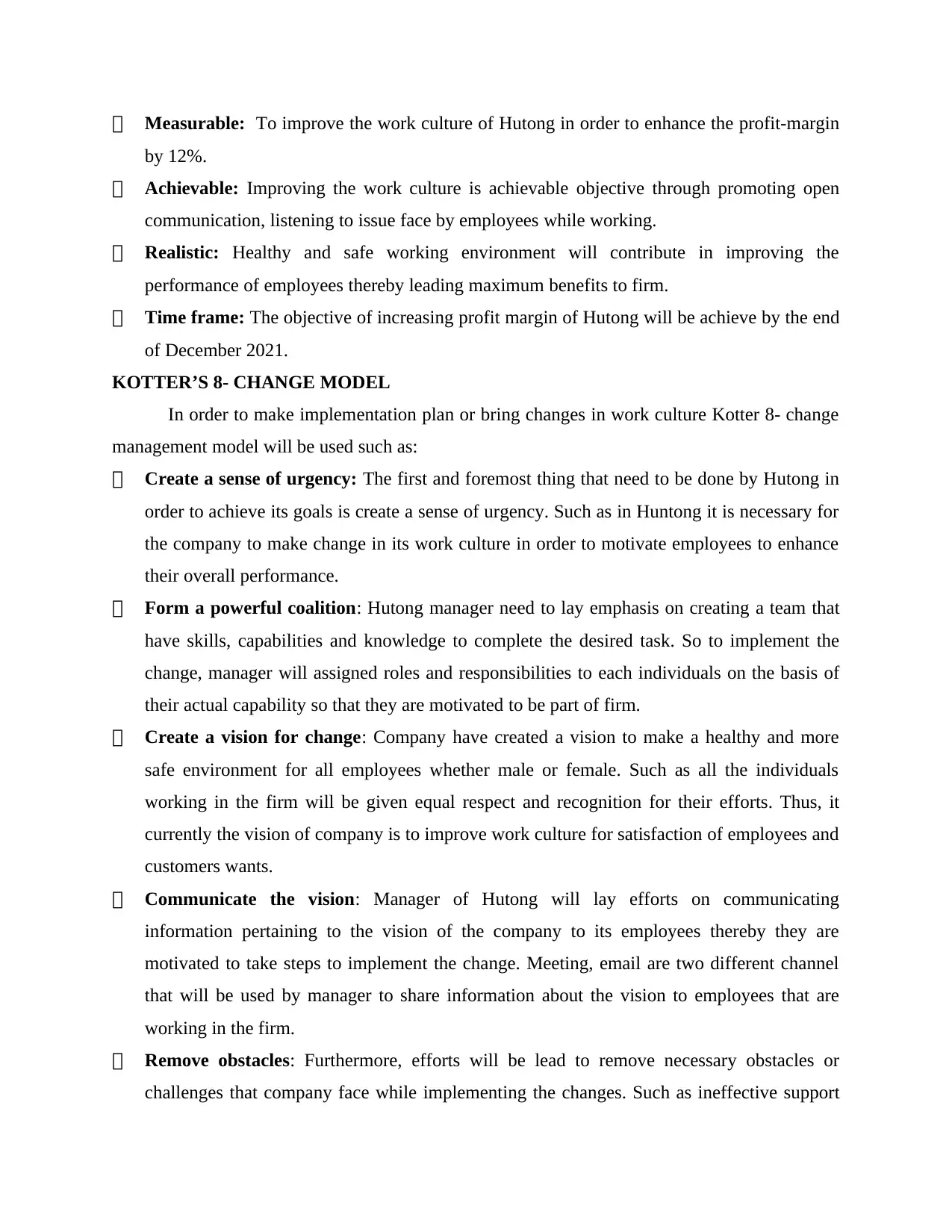
Measurable: To improve the work culture of Hutong in order to enhance the profit-margin
by 12%.
Achievable: Improving the work culture is achievable objective through promoting open
communication, listening to issue face by employees while working.
Realistic: Healthy and safe working environment will contribute in improving the
performance of employees thereby leading maximum benefits to firm.
Time frame: The objective of increasing profit margin of Hutong will be achieve by the end
of December 2021.
KOTTER’S 8- CHANGE MODEL
In order to make implementation plan or bring changes in work culture Kotter 8- change
management model will be used such as:
Create a sense of urgency: The first and foremost thing that need to be done by Hutong in
order to achieve its goals is create a sense of urgency. Such as in Huntong it is necessary for
the company to make change in its work culture in order to motivate employees to enhance
their overall performance.
Form a powerful coalition: Hutong manager need to lay emphasis on creating a team that
have skills, capabilities and knowledge to complete the desired task. So to implement the
change, manager will assigned roles and responsibilities to each individuals on the basis of
their actual capability so that they are motivated to be part of firm.
Create a vision for change: Company have created a vision to make a healthy and more
safe environment for all employees whether male or female. Such as all the individuals
working in the firm will be given equal respect and recognition for their efforts. Thus, it
currently the vision of company is to improve work culture for satisfaction of employees and
customers wants.
Communicate the vision: Manager of Hutong will lay efforts on communicating
information pertaining to the vision of the company to its employees thereby they are
motivated to take steps to implement the change. Meeting, email are two different channel
that will be used by manager to share information about the vision to employees that are
working in the firm.
Remove obstacles: Furthermore, efforts will be lead to remove necessary obstacles or
challenges that company face while implementing the changes. Such as ineffective support
by 12%.
Achievable: Improving the work culture is achievable objective through promoting open
communication, listening to issue face by employees while working.
Realistic: Healthy and safe working environment will contribute in improving the
performance of employees thereby leading maximum benefits to firm.
Time frame: The objective of increasing profit margin of Hutong will be achieve by the end
of December 2021.
KOTTER’S 8- CHANGE MODEL
In order to make implementation plan or bring changes in work culture Kotter 8- change
management model will be used such as:
Create a sense of urgency: The first and foremost thing that need to be done by Hutong in
order to achieve its goals is create a sense of urgency. Such as in Huntong it is necessary for
the company to make change in its work culture in order to motivate employees to enhance
their overall performance.
Form a powerful coalition: Hutong manager need to lay emphasis on creating a team that
have skills, capabilities and knowledge to complete the desired task. So to implement the
change, manager will assigned roles and responsibilities to each individuals on the basis of
their actual capability so that they are motivated to be part of firm.
Create a vision for change: Company have created a vision to make a healthy and more
safe environment for all employees whether male or female. Such as all the individuals
working in the firm will be given equal respect and recognition for their efforts. Thus, it
currently the vision of company is to improve work culture for satisfaction of employees and
customers wants.
Communicate the vision: Manager of Hutong will lay efforts on communicating
information pertaining to the vision of the company to its employees thereby they are
motivated to take steps to implement the change. Meeting, email are two different channel
that will be used by manager to share information about the vision to employees that are
working in the firm.
Remove obstacles: Furthermore, efforts will be lead to remove necessary obstacles or
challenges that company face while implementing the changes. Such as ineffective support
⊘ This is a preview!⊘
Do you want full access?
Subscribe today to unlock all pages.

Trusted by 1+ million students worldwide
1 out of 16
Related Documents
Your All-in-One AI-Powered Toolkit for Academic Success.
+13062052269
info@desklib.com
Available 24*7 on WhatsApp / Email
![[object Object]](/_next/static/media/star-bottom.7253800d.svg)
Unlock your academic potential
Copyright © 2020–2025 A2Z Services. All Rights Reserved. Developed and managed by ZUCOL.




